Most of our senior citizens are stricken with some kind of hip problem or weakness. It happens due to having weak hip joints and a lack of hip exercises.
Hip Strengthening exercises for seniors are beneficial to our health and well-being as we age. You see, as we grow older, maintaining strong hips becomes increasingly important.
Why, you ask? Well, the truth is our hips are the foundation of our body. The hip area supports your movements, balance, and overall stability.
So, if we make our hip muscles strong, we can prevent pain, and injuries, and reduce the risk of falls. Plus, strong hips mean staying independent and mobile, which is something we all cherish, right?
Here, we explore some simple yet effective exercises customised specifically for seniors. Trust me, if you include these workouts in your daily life, they can make a world of difference in how you feel and move.
So, stay with us as we journey towards stronger hips and a healthier lifestyle together. Stay sharp.
Importance of Hip Strength for Seniors
As we journey through life, our bodies undergo various changes, especially as we age. One area that often requires special attention is our hips. These joints in the hips play an important part in our mobility, balance, and overall well-being.
As a senior, you must maintain your hip strength and mobility to enjoy an active lifestyle. So, you should know why hip strength holds such significance for seniors and how it might impact your daily lives.
Enhance Stability and Balance
Strong hip muscles contribute significantly to the stability and balance of the body. It is fundamental for preventing falls and maintaining independence.
If you hone the muscles around the hip joint, you can support your body weight and navigate various activities in old age with confidence.
Greatly Reduces the Risk of Injury
Weak hips can lead to poor alignment and posture, increasing the risk of injuries. These could be into your lower back, knees, and ankles.
If you keep hip-strengthening exercises in your routine, you can mitigate these risks. Thus you will have safer movements and fewer strains or sprains.
Better Mobility and Functionality
Adequate hip strength is vital for performing daily tasks, such as standing up from a chair, walking, or climbing stairs, with ease.
Strong hip muscles help you to maintain your mobility and functional independence. It will enable you to engage in activities you enjoy without age limitations.
Alleviation of Joint Pain
For seniors dealing with conditions like osteoarthritis, strengthening the muscles surrounding the hip joint can help alleviate pain and discomfort.
Strengthening the hips offers better support and stability to the affected area. So, strong hips can enhance your joint function. It will also reduce the impact of arthritis on your daily life.
Improve the Quality of Life
Hip strength directly impacts seniors’ quality of life. It helps them to remain active, engaged, and independent. With strong hips, you can continue participating in hobbies, and social activities. You can also continue gardening and playing with children, as in the old days for having a strong hip area.
Long-Term Health Benefits
If you invest in hip strength, it will provide long-term health benefits as you grow old. The strong hip area will improve bone density, and reduce the risk of chronic conditions like osteoporosis.
If you take care of your hip health, you can enjoy a higher quality of life and age gracefully while maintaining your independence.
Hip strength is not just about muscle power; it’s about preserving freedom, mobility, and vitality as we age.
8 Effective Hip Strengthening Exercises for Seniors
Take a look at some of the hip-strengthening exercises tailored specifically for seniors like you. Strengthening our hips can make a world of difference in our mobility, stability, and overall well-being as we age.
So, you should go through the following section attentively if you want to develop your ageing hip areas.
1. Standing Hip Flexor (SHF)
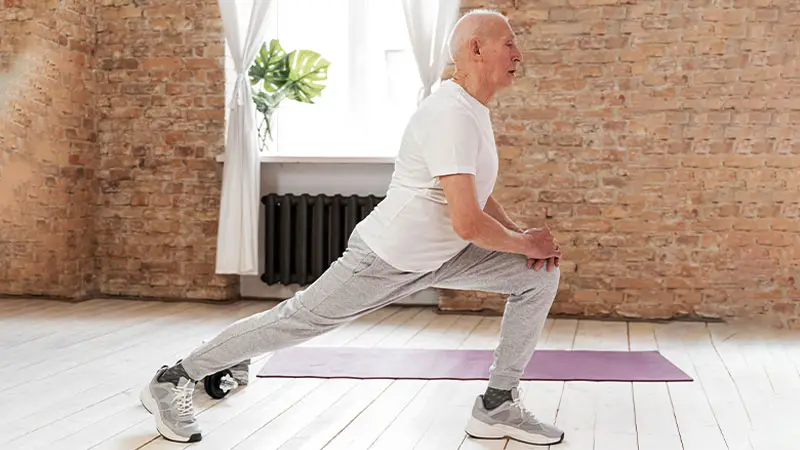
The standing hip flexor exercise targets the hip flexors, a core set of muscles responsible for lifting the thigh towards the torso.
Strengthening these muscles aids in maintaining proper posture. It is essential for your overall stability and balance. These muscles come into direct actions during activities like walking or standing up from a seated position.
Additionally, if you possess strong hip flexors, they will improve hip joint mobility. As a bonus, you will have near zero risk of stiffness and discomfort in movements.
Instructions:
- Stand with your feet apart and one foot slightly forward.
- Bend the knee of the forward leg while keeping the other leg straight.
- After that, lift the heel of the straight leg off the floor while squeezing the glute.
- Hold for a few seconds, engaging the core muscles for balance.
- Slowly return to the starting position and repeat on the other side.
2. Clamshell Exercise
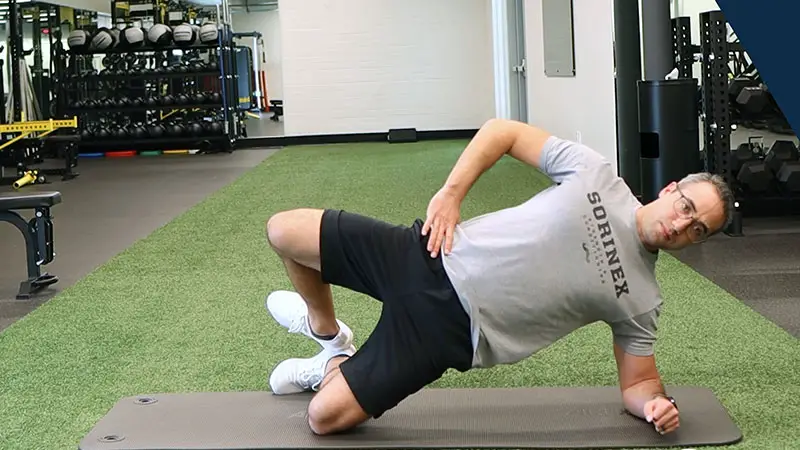
The clamshell exercise primarily targets the hip abductors, including the gluteus medius and minimus muscles.
If you strengthen these muscles, they will enhance hip stability and prevent excessive inward collapse of the knees during weight-bearing activities.
If you need to walk or climb stairs regularly this workout will help you dearly. So, you should improve your hip abduction strength to alleviate strain on the lower back and hips.
Instructions:
- Firstly, lie on your side with your knees bent and feet together.
- Keeping your feet together, lift the top knee upward while maintaining alignment of the hips.
- Hold the position briefly, focusing on engaging the outer hip muscles.
- Then slowly lower the knee back down to meet the other knee.
- Repeat for the desired number of repetitions before switching sides.
3. Hip Bridges
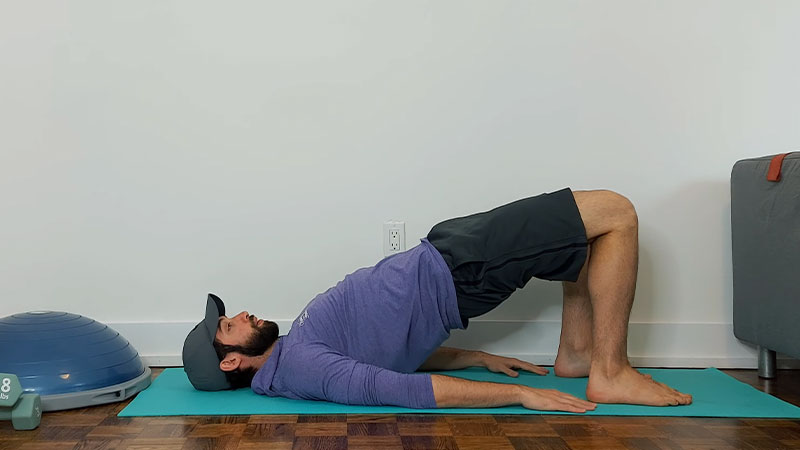
Hip bridges are effective for targeting the posterior chain muscles, including the glutes, hamstrings, and lower back.
If you want to improve hip extension you should make your hip bridges strong. It is also essential for activities like standing up from a seated position or climbing stairs.
Additionally, hip bridges promote our spinal stability and help alleviate lower back pain by engaging the muscles that support the lumbar spine.
Instructions:
- Lie on your back with your knees bent and feet flat on the floor.
- Engage your core muscles and press through your heels to lift your hips off the floor.
- Squeeze your glutes at the top of the movement, maintaining a straight line from shoulders to knees.
- Then, hold for a moment before slowly lowering your hips back down.
- You have to repeat for the desired number of repetitions, focusing on controlled movement.
4. Hip Marches
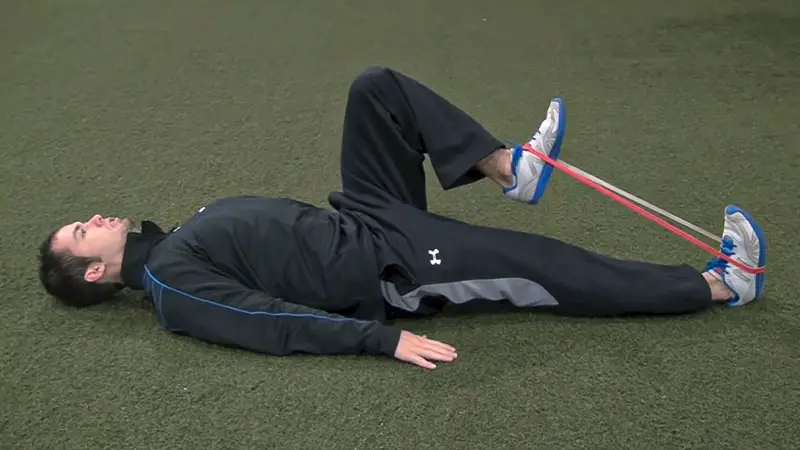
Hip marches are a functional exercise that targets our hip flexors and improves our hip mobility.
By lifting the knees towards the chest in a seated position, we seniors can strengthen the muscles involved in hip flexion. It will surely enhance our range of motion in the hip joints.
This exercise also promotes balance and coordination. So, it is beneficial for you if you need to walk and stair climb on a daily basis.
Instructions:
- Initially, sit upright in a chair with your feet flat on the floor.
- Lift one knee towards your chest as high as comfortably possible.
- Hold the position briefly, maintaining balance with your core muscles.
- After that slowly lower the foot back to the floor and repeat with the other leg.
- Continue alternating legs for the desired number of repetitions.
5. Fire Hydrant Exercise
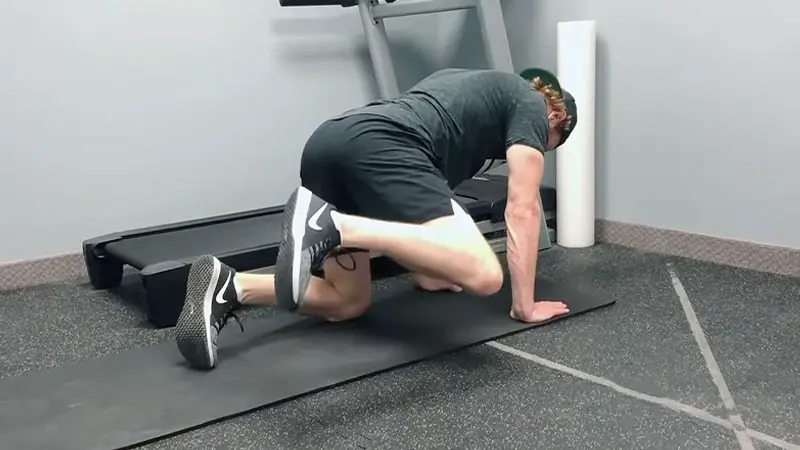
The fire hydrant exercise targets our hip abductors and external rotators, which are essential for the mobility of our hips.
If you perform this workout regularly, it can improve your balance and coordination, as well as reduce the risk of falls and injuries.
Additionally, the fire hydrant exercise helps us to alleviate tightness in the hips and lower back.
Instructions:
- You need to start on all fours with your hands directly under your shoulders and knees under your hips.
- Keeping your knee bent, lift one leg out to the side at a 90-degree angle.
- Make sure to focus on engaging the outer hip muscles as you lift the leg.
- Hold the position briefly before lowering the leg back down with control.
- Finally, repeat on the other side, alternating legs for the desired number of repetitions.
6. Standing Hip Abductors
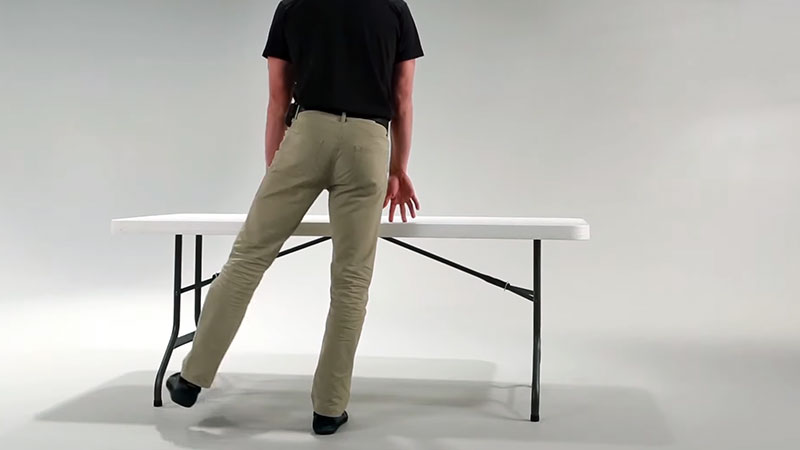
Standing hip abductors target the hip abductors and improve lateral stability and balance. This exercise mimics the motion of stepping sideways. As you know, this is very essential for navigating obstacles and maintaining stability during daily activities.
Instructions:
- First, stand upright with your feet hip-width apart and hold onto a chair or wall for support if needed.
- Lift one leg out to the side in a controlled motion, keeping the knee straight.
- Focus on engaging the muscles along the outer hip as you lift the leg.
- Then, hold the position briefly before lowering the leg back to the ground.
- Repeat on the other side, alternating legs for the desired number of repetitions.
7. Hip Circles
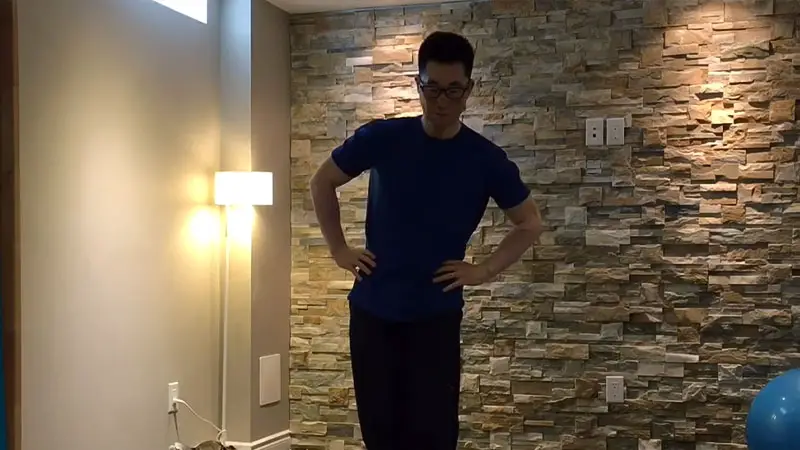
The next one is Hip circles. This one is a dynamic exercise that targets multiple hip muscles, including the hip flexors, abductors, and rotators. Performing circular motions with the hips helps to improve your joint mobility and flexibility
It can also reduce stiffness and discomfort. Hip circles also promote circulation to the hip joints, enhancing nutrient delivery and waste removal for optimal joint health.
Instructions:
- Stand with your feet hip-width apart and hands on your hips for stability.
- Begin by making small circular motions with your hips, gradually increasing the size of the circles.
- Make sure to focus on moving smoothly and fluidly, engaging the muscles throughout the range of motion.
- After completing several repetitions in one direction, switch to the opposite direction to work different muscle groups.
- Continue alternating directions for the desired number of repetitions, aiming for a full range of motion.
8. Hip Flexor Stretch
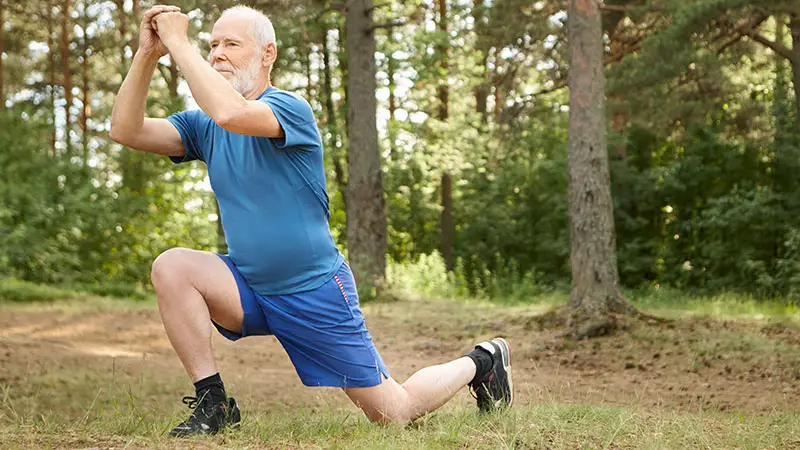
Finally, it is the Hip Flexor Stretch. Stretching the hip flexors helps to alleviate tightness and improve hip mobility, particularly for seniors who spend prolonged periods sitting.
By lengthening the muscles at the front of the hip, this stretch can reduce discomfort and improve the range of motion, making daily activities like walking and standing more comfortable.
Regular hip flexor stretching also promotes better posture and spinal alignment, reducing the risk of lower back pain.
Instructions:
- Kneel on one knee with the other foot flat on the floor in front of you.
- Engage your core muscles to stabilise your torso, avoiding arching your lower back.
- Gently lean forward, shifting your weight onto the front foot, until you feel a stretch in the front of the hip and thigh.
- After that, hold the stretch for 15-30 seconds, breathing deeply and relaxing into the stretch without bouncing.
- Switch legs and repeat the stretch on the opposite side, aiming for symmetry in flexibility between both sides.
All these hip-strengthening exercises are very effective and beneficial. Once you manage to incorporate them into your routine, it will make a significant difference in your mobility, stability, and overall quality of life as a senior.
Remember to start slowly, listen to your body, and gradually increase the intensity and duration of each exercise over time. With dedication and consistency, you can build stronger, healthier hips and enjoy an active lifestyle for years to come.
Additional Tips for Safe and Effective Hip Strengthening for Seniors
Undoubtedly, the mentioned Hip Strengthening exercises are effective and essential for seniors. But all of them possess certain risk factors. You should be careful of them and some tricks can help you in this case.
Here are some of the additional guidelines to maximise the benefits of your workouts while minimising the risk of injury.
Start with Warm-Up
Before diving into hip strengthening exercises, it’s essential to prepare your body with a proper warm-up. Try some light cardiovascular activities such as marching on the spot or side-stepping for about 5-10 minutes.
It helps increase blood flow to the muscles, raises body temperature, and primes your body for the upcoming workout, reducing the risk of strains or sprains.
Prioritise Hip Mobility Exercises Will Help
Incorporating hip mobility exercises into your routine can help improve flexibility and range of motion in the hips. It will enhance the effectiveness of your strengthening exercises.
You can include movements like hip circles, hip marches, and knee hugs to target different planes of motion and ensure optimal joint health and function.
Focus on Technique Matters
You should pay close attention to proper technique and form during hip strengthening exercises to maximise their effectiveness and minimise the risk of injury.
Ensure that you maintain proper alignment, engage the correct muscles, and move through the full range of motion with control. If needed, seek guidance from a qualified fitness professional to ensure proper execution.
Gradual Progression Is A Better Idea
At any cost, you have to avoid pushing yourself too hard or progressing too quickly with hip-strengthening exercises. It’s better to gradually increase the intensity, duration, or resistance of your workouts over time.
It’ll help your muscles and joints to adapt and strengthen safely. Make sure to listen to your body and adjust your routine accordingly to prevent overexertion or burnout.
Rest and Recovery Are The Must
Finally, prioritise adequate rest and recovery between hip strengthening workouts to allow your muscles to repair and grow stronger. You should aim for at least 48 hours of rest between sessions targeting the same muscle groups to prevent overtraining.
This interval will reduce the risk of injury. You should incorporate gentle stretching, foam rolling, or low-impact activities on rest days to promote muscle recovery and maintain flexibility.
Make sure to follow these additional tips for safe and effective hip strengthening. As a senior, you can optimise your workouts and reduce the risk of injury in this way.
These tricks will also help you achieve greater success in improving hip strength and overall mobility. If needed, don’t hesitate to consult a healthcare professional.
Wrapping Up
Prioritising hip strengthening exercises is a game-changer for seniors like us. It helps us maintain an active and independent lifestyle. Adding targeted exercises into our routine can help us improve stability, mobility, and overall quality of life.
Remember, it’s never too late to start investing in our hip health. With consistency, patience, and proper guidance, we can reap the benefits of stronger hips, reduced risk of falls, and enhanced well-being.
So let’s take charge of our health, one exercise at a time. Together, we can build a stronger foundation for a fulfilling and vibrant life, embracing each day with confidence and vitality. Here’s to stronger hips and a happier, healthier tomorrow!
I am a fitness instructor and I have been in the industry for 9 years. I have a passion for health and fitness.
I am a fitness instructor with over 9 years of experience in the industry. My passion is health and fitness and I would love to share my knowledge with you!